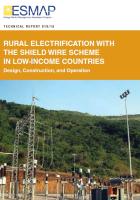Publications
The manual begins with a description of the concept and aims of the shield wire scheme (SWS). The scheme is applicable for minimum cost power supply from the grid to villages, small towns, farms, factories, and water pumping stations located near or at some distance from the route of the high-voltage (HV), 110 to 330 kV, transmission lines (TLs).
The SWS is a solution for rural electrification that is not economically justifiable with conventional solutions, which are long medium-voltage (MV) lines routed along the HV TLs or dedicated HV/MV transformer stations. SWSs consist of the following: Insulating the shield wires (SWs) from the towers of the HV TL for MV operation (20 to 34.5 kV). Energizing the SWs at MV from the HV/MV transformer station at one end of the HV TL. Using the earth return of current as an MV distribution conductor. Supplying the loads by means of medium-voltage/low-voltage (MV/LV) distribution transformers connected between the SWs and the ground.
Iliceto, Francesco. 2016. Rural Electrification with the Shield Wire Scheme in Low-Income Countries: Design, Construction, and Operation. Energy Sector Management Assistance Program (ESMAP) Technical Report,010/16. World Bank, Washington, DC. © World Bank. License: CC BY 3.0 IGO. https://openknowledge.worldbank.org/handle/10986/26647


